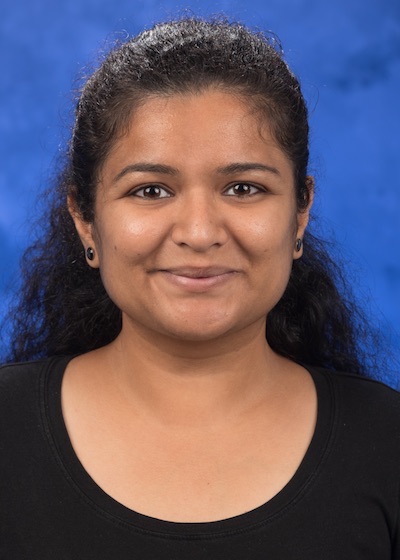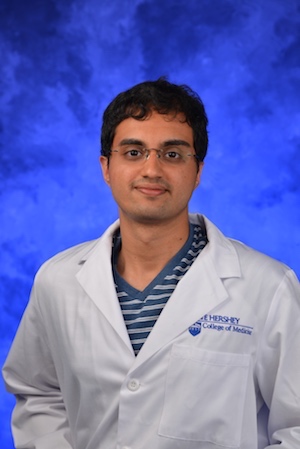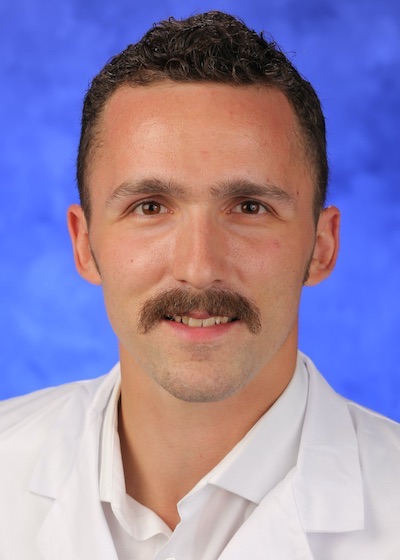The background image is Images of brain MRI scans showing a tumor in a person's head are seen on a dark background.
The leading edge of neuro-oncology research
The Department of Neurosurgery at Penn State College of Medicine is committed to advancing treatments for neuro-oncology through research. Faculty are involved in clinical and basic research, including clinical trials, clinically based research, preclinical and translational research.
At the 2019 Society for Neuro-Oncology Annual Meeting, the department presented its latest innovations in the diagnosis, treatment and management of glioblastomas and neoplastic meningitis.
Explore these projects below.
College of Medicine identifies impact of sex, genes and iron on glioblastoma outcomes
For more than 30 years, James Connor, PhD, has studied iron metabolism in the brain. He has investigated the mechanisms of iron mobilization, function and regulation in the brain and how this contributes to cancer, central nervous system aging and disease.
Recently, Connor and co-investigators at Penn State College of Medicine and beyond have begun to explore the “iron signature” of brain tumors.
Within the past five years, Connor has led collaborations with researchers at Cleveland Clinic and Washington University in St. Louis to understand sex-based differences in glioblastoma outcomes.
Connor continues to study how tumors acquire iron and what they do with it and whether manipulating these actions can affect tumor growth.
James Connor, MS, PhD

Distinguished Professor and Vice Chair for Research, Department of Neurosurgery
Professor, Department of Neural and Behavioral Sciences
Professor, Department of Pediatrics
Member, Penn State Cancer Institute
“The iron signature of a tumor is sex-dependent and includes iron acquisition mechanisms and gene profiles. Our work has helped us identify, characterize and manipulate these aspects of the tumor with the goal of improving survival and quality of life.”
– James Connor, PhD
Sex specificity
The sex of a glioblastoma patient impacts their clinical outcome. Iron is a key metabolic driver in glioma biology impacting both neoplastic cells directly and tumor progression through the immune system.
Connor and colleagues identified a new function in iron delivery for a protein called ferritin that operates in a sex-specific fashion.
High expression of ferritin is known to be associated with poor overall survival in glioblastoma patients.
The Connor lab is actively investigating sex-dependent uptake of ferritin and whether blocking expression of ferritin in tumor cells might increase their sensitivity to treatment.
Gene expression profiles
The other key factor in understanding the iron signature of glioblastomas is their gene expression profiles.
Members of the Connor Lab are investigating if there are sex-specific differences in the expression of iron metabolism-related genes.
Gene profiling revealed that some members of the immune cell family within tumors may be determining sex-related outcomes.
The lab continues to investigate how manipulating these immune cells might change the iron signature of tumors with the ultimate goal of improving prognosis for glioblastoma patients.
College of Medicine collaborators
Coinvestigators
Vonn Walter, PhD

Assistant Professor, Department of Biochemistry and Molecular Biology
Assistant Professor, Department of Public Health Sciences, Division of Biostatistics and Bioinformatics
Member, Penn State Cancer Institute
Member, Institute for Personalized Medicine
Elizabeth Ann Proctor, PhD

Associate Professor, Department of Neurosurgery
Associate Professor, Department of Pharmacology
Associate Professor, Department of Biomedical Engineering
Brad Zacharia, MD, MS

Associate Professor, Department of Neurosurgery
Affiliate, Penn State Cancer Institute
Todd Schell, PhD

Professor, Department of Microbiology and Immunology
Member, Penn State Cancer Institute
Vonn Walter, PhD

Assistant Professor, Department of Biochemistry and Molecular Biology
Assistant Professor, Department of Public Health Sciences, Division of Biostatistics and Bioinformatics
Member, Penn State Cancer Institute
Member, Institute for Personalized Medicine
Elizabeth Ann Proctor, PhD

Associate Professor, Department of Neurosurgery
Associate Professor, Department of Pharmacology
Associate Professor, Department of Biomedical Engineering
Brad Zacharia, MD, MS

Associate Professor, Department of Neurosurgery
Affiliate, Penn State Cancer Institute
Todd Schell, PhD

Professor, Department of Microbiology and Immunology
Member, Penn State Cancer Institute
Trainees
Bhavyata Pandya
 Biomedical Sciences PhD student
Biomedical Sciences PhD studentGanesh Shenoy
 MD/PhD student (Biomedical Sciences PhD)
MD/PhD student (Biomedical Sciences PhD)Vladimir Khristov
 MD/PhD student (Biomedical Sciences PhD)
MD/PhD student (Biomedical Sciences PhD)Darya “Dasha” Nesterova
 Biomedical Sciences PhD student
Biomedical Sciences PhD studentVagisha Ravi, PhD
 Biomedical Sciences PhD graduate
Biomedical Sciences PhD graduateBhavyata Pandya
 Biomedical Sciences PhD student
Biomedical Sciences PhD studentGanesh Shenoy
 MD/PhD student (Biomedical Sciences PhD)
MD/PhD student (Biomedical Sciences PhD)Vladimir Khristov
 MD/PhD student (Biomedical Sciences PhD)
MD/PhD student (Biomedical Sciences PhD)Darya “Dasha” Nesterova
 Biomedical Sciences PhD student
Biomedical Sciences PhD studentVagisha Ravi, PhD
 Biomedical Sciences PhD graduate
Biomedical Sciences PhD graduate
Vonn Walter, PhD

Assistant Professor, Department of Biochemistry and Molecular Biology
Assistant Professor, Department of Public Health Sciences, Division of Biostatistics and Bioinformatics
Member, Penn State Cancer Institute
Member, Institute for Personalized Medicine
Elizabeth Ann Proctor, PhD

Associate Professor, Department of Neurosurgery
Associate Professor, Department of Pharmacology
Associate Professor, Department of Biomedical Engineering
Brad Zacharia, MD, MS

Associate Professor, Department of Neurosurgery
Affiliate, Penn State Cancer Institute
Todd Schell, PhD

Professor, Department of Microbiology and Immunology
Member, Penn State Cancer Institute
Vonn Walter, PhD

Assistant Professor, Department of Biochemistry and Molecular Biology
Assistant Professor, Department of Public Health Sciences, Division of Biostatistics and Bioinformatics
Member, Penn State Cancer Institute
Member, Institute for Personalized Medicine
Elizabeth Ann Proctor, PhD

Associate Professor, Department of Neurosurgery
Associate Professor, Department of Pharmacology
Associate Professor, Department of Biomedical Engineering
Brad Zacharia, MD, MS

Associate Professor, Department of Neurosurgery
Affiliate, Penn State Cancer Institute
Todd Schell, PhD

Professor, Department of Microbiology and Immunology
Member, Penn State Cancer Institute
Bhavyata Pandya

Ganesh Shenoy

Vladimir Khristov

Darya “Dasha” Nesterova

Vagisha Ravi, PhD

Bhavyata Pandya

Ganesh Shenoy

Vladimir Khristov

Darya “Dasha” Nesterova

Vagisha Ravi, PhD

College of Medicine advances diagnosis, treatment and management of neoplastic meningitis
Oncology research continues to identify ways to better control cancers that occur outside the nervous system. However, many therapies can’t access the nervous system and may be poor options for treating neoplastic meningitis.
When cancer cells metastasize to the nervous system, functions like eye and facial movements, speech, swallowing, vision and hearing are affected.
Under the leadership of Michael Glantz, MD, PhD, Brad Zacharia, MD, MS, and Dawit Aregawi, MD, Penn State College of Medicine continues to investigate the best approaches for diagnosing, treating and managing neoplastic meningitis.

Michael Glantz, MD, PhD
Professor, Department of Neurosurgery
Professor, Department of Medicine
Affiliate, Penn State Cancer Institute

Brad Zacharia, MD, MS
Associate Professor, Department of Neurosurgery
Affiliate, Penn State Cancer Institute

Dawit Aregawi, MD
Assistant Professor, Department of Neurosurgery
Member, Penn State Cancer Institute

Michael Glantz, MD, PhD
Professor, Department of Neurosurgery
Professor, Department of Medicine
Affiliate, Penn State Cancer Institute

Brad Zacharia, MD, MS
Associate Professor, Department of Neurosurgery
Affiliate, Penn State Cancer Institute

Dawit Aregawi, MD
Assistant Professor, Department of Neurosurgery
Member, Penn State Cancer Institute
“Neoplastic meningitis is an increasingly frequent complication of cancer. Novel treatment strategies have completely revised the traditional view of an untreatable disease with a dismal prognosis.”
– Michael Glantz, MD, PhD
Diagnosing: How do CSF cytology and MRI scanning compare?
Analyzing cerebrospinal fluid for tumor cells has been the standard method for diagnosing neoplastic meningitis.
While this method is specific, it is only 50 percent sensitive. Magnetic resonance imaging (MRI) is another method used to diagnose this disease, but the sensitivity and specificity of MRI have not been established, and the ability of MRI scanning to predict outcomes is also unknown.
Using data from the International Neoplastic Meningitis Registry, which is managed by Penn State College of Medicine, researchers investigated the difference in outcomes between the two diagnostic techniques. They learned that patients diagnosed by various combinations of cytology and MRI positivity had different survival.
These findings have implications for patient care, clinical trial design and interpretation and discussions about prognosis.
Novel diagnostic strategies for neoplastic meningitis being developed by these same researchers are being subjected to a similar analysis.
Treating: Are four drugs better than one?
The standard of care for treating neoplastic meningitis is to use radiation therapy for specific sites where symptoms occur, followed by delivery of chemotherapy directly into the spinal fluid by way of a ventricular catheter (an Ommaya reservoir), a technique which allows drugs to circumvent the blood-brain barrier.
The current standard of care for patients with neoplastic meningitis (in contrast to the approach for most patients with cancer outside of the nervous system) calls for administering a single drug into the spinal fluid.
Researchers at Penn State College of Medicine compared this single-agent approach to a multi-agent approach and found that patients who received multi-agent therapy had a dramatically improved survival and similar or reduced toxicity compared to those receiving single-agent therapy.
Managing: Is it a seizure or something different?
Neoplastic meningitis causes a variety of symptoms, including headaches, nausea, vomiting and fatigue and focal neurologic dysfunction.
Approximately 10 percent of patients experience what researchers at Penn State College of Medicine have termed “plateau wave events.”
While these events may mimic seizures, seizure medications are ineffective for this problem.
Plateau wave events are caused by abrupt increases in intracranial pressure, which cause patients to lose consciousness and motor tone. Reducing intracranial pressure through ventriculoperitoneal shunting results in immediate symptom resolution.
College of Medicine supporters and collaborators
Robert Harbaugh, MD

Distinguished Professor, Department of Neurosurgery
Affiliate, Penn State Cancer Institute
Elias Rizk, MD, MSc

Associate Professor, Department of Neurosurgery
Member, Penn State Cancer Institute
Neuroscience PhD student
Other contributors
- Kirsten Shuler, Research Project Manager, Penn State Neuroscience Institute
- Shwetha Srikanth, Research Data Manager, Penn State Neuroscience Institute
- Christopher Messner, MD student
- Samer Zammar, Neurosurgery resident
- Varun Padmanaban, Neurosurgery resident
- Sandra Ryan, Clinical Nursing Coordinator
- Sambina Roschella, Nurse Practitioner, Department of Neurosurgery
Robert Harbaugh, MD

Distinguished Professor, Department of Neurosurgery
Affiliate, Penn State Cancer Institute
Elias Rizk, MD, MSc

Associate Professor, Department of Neurosurgery
Member, Penn State Cancer Institute
Neuroscience PhD student
Other contributors
- Kirsten Shuler, Research Project Manager, Penn State Neuroscience Institute
- Shwetha Srikanth, Research Data Manager, Penn State Neuroscience Institute
- Christopher Messner, MD student
- Samer Zammar, Neurosurgery resident
- Varun Padmanaban, Neurosurgery resident
- Sandra Ryan, Clinical Nursing Coordinator
- Sambina Roschella, Nurse Practitioner, Department of Neurosurgery
